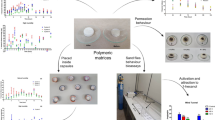Abstract
An apparatus was developed for investigating the release rates of pheromone formulations at temperatures and air velocities that correspond with those in the field. Polyurethane foam proved an excellent adsorbent for the recovery of tetradecen-1-ol acetates, allowing high air flows at low differential pressure and without breakthrough of these compounds. The experimental setup and procedures are described. The release rates of all formulations investigated were almost proportional to the square root of air velocity, and their logarithms were proportional to the reciprocal of temperature (K). When temperature is increased from 15°C to 25°C, the release rates increase by about 2-2.5 ×. Both relationships were combined into one equation that allows a reliable estimate to be made of the actual release rates of a formulation, under varying conditions, on the basis of its specific parameters and the relevant meteorological data.
Similar content being viewed by others
References
Anonymous. 1972. Klimaatatlas van Nederland. Koninklijk Nederlands Meteorologisch Instituut, Staatsuitgeverij, 's-Gravenhage.
Aylor, D.E. 1976. Estimating peak concentrations of pheromones in the forest, pp. 177–188,in J. F. Anderson and H.K. Kaya (eds.). Perspectives in Forest Entomology. Academic Press, New York.
Beroza, M., Bierl, B.A., James, P., andDe Vilbiss, E.D. 1975. Measuring emission rates of pheromones from their formulations.J. Econ. Entomol. 68:369–372.
Bierl, B.A., DeVilbiss, E.D., andPlimmer, J.R. 1976. Use of pheromones in insect control programs: Slow release formulations, pp. 265–272,in D.R. Paul and F.W. Harris (eds.). Controlled Release Polymeric Formulations. ACS Symposium Series No. 33, American Chemical Society, Washington, D.C.
Bierl-Leonhardt, B.A. 1982. Release rates from formulations and quality control methods, pp. 245–258,in A.F. Kydonieus and M. Beroza (eds.). Insect Suppression with Controlled Release Pheromone Systems I. CRC Press, Boca Raton, Florida.
Bierl-Leonhardt, B.A., Devilbiss, E.D., andPlimmer, J.R. 1979. Rate of release of disparlure from laminated plastic dispensers.J. Econ. Entomol. 72:319–321.
Bossert, W.H., andWilson, E.O. 1963. The analysis of olfactory communication among animals.J. Theor. Biol. 5:443–469.
Butler, L.I., andMcDonough, L.M. 1979. Insect sex pheromones: Evaporation rates of acetates from natural rubber septa.J. Chem. Ecol. 5:825–837.
Butler, L.I., andMcDonouoh, L.M. 1981. Insect sex pheromones: Evaporation rates of alcohols and acetates from natural rubber septa.J. Chem. Ecol. 7:627–633.
Campion, D.G. 1984. Survey of pheromone uses in pest control, pp. 405–449,in H.E. Hummel and T.A. Miller (eds.). Techniques in Pheromone Research. Springer-Verlag, New York.
Card, J.H., Bierl, B.A., Freeman, H.P., Glotfelty, D.E., andTurner, B.C. 1977. Disparlure: Volatilization rates of two microencapsulated formulations from a grass field.Environ. Entomol. 6:877–881.
Caro, J.H., Bierl, B.A., Freeman, H.P., andSonnet, P.E. 1978. A method for trapping disparlure from air and its determination by electron-capture gas chromatography.J. Agric. Food Chem. 26:461–463.
Daterman, G.E. 1982. Monitoring insects with pheromones: Trapping objectives and bait formulations, pp. 155–163,in A.F. Kydonieus and M. Beroza (eds.). Insect Suppression with Controlled Release Pheromone Systems I. CRC Press, Boca Raton, Florida.
Gaston, L.K., Shorey, H.H., andSaario, C.A. 1971. Sex pheromones of noctuid moths. XVIII. Rate of evaporation of a model compound ofTrichoplusia ni sex pheromone from different substrates at various temperatures and its application to insect orientation.Ann. Entomol. Soc. Am. 64:381–384.
Golub, M.A., andWbatherston, I. 1984. Techniques for extracting and collecting sex pheromones from live insects and from artificial sources, pp. 223–285,in H.E. Hummel and T.A. Miller (eds.). Techniques in Pheromome Research. Springer-Verlag, New York.
Golub, M., Weatherston, J., andBenn, M.H. 1983. Measurement of release rates of gossyplure from controlled release formulations by mini-airflow method.J. Chem. Ecol. 9:323–333.
Gückel, W., Synnatschke, G., andRittig, R. 1973. A method for determining the volatility of active ingredients used in plant protection.Pestic. Sci. 4:137–147.
Hirooka, Y., andSuwanai, M. 1976. Role of insect sex pheromone in mating behavior I. Theoretical consideration on release and diffusion of sex pheromone in the air.Appl. Entomol. Zool. 11:126–132.
Hirooka, Y., andSuwanai, M. 1978. Role of insect sex pheromone in mating behavior II. An aspect of sex pheromone as a volatile material.Appl. Entomol. Zool. 13:38–43.
Ioriatti, C., Charmillot, P.J., andBloesch, B. 1987. Etude des principaux facteurs influencant l'émission d'attractifs sexuels synthétiques à partir de diffuseurs en caoutchouc et en plastique.Entomol. Exp. Appl. 44:123–130.
Kraan, C. Van Der. 1984. Release rate and effects of sex pheromones, depending on formulation, temperature and wind velocity, pp. 44–45,in Abstracts of joint EPRS/WPRS IOBC Conference on Attractant Pheromones, September 18-22, 1984, Balatonalmádi, Hungary.
Kydonieus, A.F., andBeroza, M. 1982. Pheromones and their use, pp. 3–12,in A.F. Kydonieus and M. Beroza (eds.). Insect Suppression with Controlled Release Pheromone Systems I. CRC Press, Boca Raton, Florida.
Olsson, A.-M., Jönsson, J.A., Thelin, B., andLiljefors, T. 1983. Determination of the vapor pressures of moth sex pheromone components by a gas chromatographie method.J. Chem. Ecol. 9:375–385.
Pope, M.M., Gaston, L.K., andBaker, T.C. 1982. Composition, quantification and periodicity of sex pheromone gland volatiles from individualHeliothis virescens females.J. Chem. Ecol. 8:1043–1055.
Qi, Y.-T., andBurkholder, W.E. 1982. Sex pheromone biology and behavior of the cowpea weevilCallosobruchus maculatus (Coleoptera: Bruchidae).J. Chem. Ecol. 8:527–534.
Rothschild, G. H. L. 1979. A comparison of methods of dispensing synthetic sex pheromone for the control of oriental fruit moth,Cydia molesta (Busck) (Lepidoptera: Tortricidae), in Australia.Bull. Entomol. Res. 69:115–127.
Sower, L.L., Gaston, L.K., andShorey, H.H. 1971. Sex pheromones of noctuid moths. XXVI. Female release rate, male response threshold, and communication distance forTrichoplusia ni.Ann. Entomol. Soc. Am. 64:1448–1456.
Turner, B.C., andGlotfelty, D.E. 1977. Field air sampling of pesticide vapors with polyurethane foam.Anal. Chem. 49:7–10.
Weatherston, J., Golub, M.A., Brooks, T.W., Huang, Y.Y., andBenn, M.H. 1981. Methodology for determining the release rate of pheromones from hollow fibers, pp. 425–443,in E.R. Mitchell (ed.). Management of Insect Pests with Semiochemicals. Plenum Press, New York.
Weatherston, J., Golub, M.A., andBenn, M.H. 1982. Release rates of pheromones from hollow fibers, pp. 145–157,in B.A. Leonhardt and M. Beroza (eds.). ACS Symposium Series No. 190, American Chemical Society, Washington, D.C.
Wiesner, C.J., andSilk, P.J. 1982. Monitoring the performance of Eastern spruce budworm pheromone formulations, pp. 209–218,in B.A. Leonhardt and M. Beroza (eds.). Insect Pheromone Technology. ACS Symposium Series No. 190, American Chemical Society, Washington, D.C.
Zeoli, L.T., Kydonieus, A.F., andQuisumbing, A.R. 1982. Controlled release technologies, pp. 131–144,in A.F. Kydonieus and M. Beroza (eds.). Insect Suppression with Controlled Release Pheromone Systems I. CRC Press, Boca Raton, Florida.
Author information
Authors and Affiliations
Rights and permissions
About this article
Cite this article
van der Kraan, C., Ebbers, A. Release rates of tetradecen-1-ol acetates from polymeric formulations in relation to temperature and air velocity. J Chem Ecol 16, 1041–1058 (1990). https://doi.org/10.1007/BF01021009
Received:
Accepted:
Issue Date:
DOI: https://doi.org/10.1007/BF01021009




